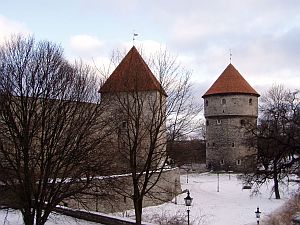History - a short overview
Nowadays, Estonia is an independent country with a full EU membership. However, full independence is a rather rare phenomenon in Estonias history. Shortly before the beginning of the common era, the tribe of the Estonians moved from somewhere behind the Ural mountains to the Baltic Sea - and so did the Finnish. After that, not much happened for a while. Finnish, Estonians, Latvians and Lithuanians settled down and fought against intruders - mainly Slavic tribes from the East. Around the year 1200, Teutonic crusaders first invaded →Latvia, shortly after that the Danish tried to conquer Estonia. It didn't work well, so the crusaders went North and christianized Estonians by force.

| ||
| Evidence of the German influence: 'Kiek in de Kök' tower |
From that time on, Danes ruled the country, but German influence grew stronger and stronger. The country started to boom. In 1347, Denmark surrendered their Estonian territories to the Teutonic Knights, hence creating the Livonian Confederation. Strong ties with the mighty Hanseatic League proved to be extremely useful. However, most Estonians were downgraded to simple farmers without any political influence. Imperial Russia wasn't lazy and tried to overrun Estonia in 1558, and so the Germans called Sweden for help. The Swedish arrived in 1561 and did much more than they were asked for. The North remained in Swedish hands, while the South became a part of the Polish-Lithuanian Commonwealth. In 1700 the Russians visited again - ironically called by the Germans. This marked the beginning of a long and cruel war. The Great Northern War soon spread over wide parts of Europe. Eventually, the war was over in 1721 and due to the Treaty of Nystad sealed in 1721 Estonia became a part of the Russian Empire. But this didn't change much - Germans ruled and Estonians starved. From 1816 to 1819, serfdom was abandoned. But that didn't change much either.
Neither the Russians nor the Germans didn't do much good to the Estonians. Several uprisings and the First World War let the situation escalate. In February 1918, Estonians declared independence of the Estonian Republic, but soon after that Estonia as well as the rest of the Baltic States was about to be occupied by Germany. The October Revolution which started in 1917 in nearby St. Petersburg had found many followers in Estonia as well. But a nationalist coalition in Estonia fought against the Bolsheviki in a long and bloody civil war. Resistance was too strong, and so Russia or the Soviet Union resp. finally renounced its claims on Estonian soil with the 1920 Tartu Peace Treaty. From 1920 to 1922, a land reform was enacted, with the result that many German-Baltic families lost their influence. Thanks to that, the situation of Estonian peasants gradually improved. But at the same time, the new country more and more developed into a dictatorship. An attempted coup d'etat failed in 1934.
In 1940, Estonia became just another victim of the secret protocol of the Molotov-Ribbentrop Pact (aka Treaty of Nonaggression between Germany and the Union of Soviet Socialist Republics) and was invaded by the Soviet Union. During the first purge in 1941, ten thousands of Estonians were murdered, deported or forced into military service in the Red Army. Pure terror reigned the country for the next time. Things didn't get much better when the Nazi German Wehrmacht occupied Estonia to make it a part of the wide Generalkommissariat Ostland (Central province of Eastland). The terror continued. But in August 1944, the Red Army took over again. Especially in 1949, the hunt for the so-called "enemies of the nation" started. Again, Estonia saw ten thousands of its citizens deported or killed. At the same time, forced collectivization of farmers, massive industrialisation and russification started. The original language, Estonian, was gradually marginalised.
And so the communist era started. Especially the environment but also the Estonian culture fell victim to the new policy. But in 1988, a silent revolution started - peacefully, slowly, and with much music. Thanks to Perestroika and Glasnost', Estonia managed to declare its independence on 20 August 1991 for the second time in its long history. Estonian became the official language again. And the Estonian culture was heavily promoted. Strong ties to Finland, the rich neighbour in the north, helped Estonia to recover quickly. On 1 May 2004, Estonia gained full EU membership without any problems. The country is very modern now - the constitution for example guarantees each of its citizens (partially free) access to the internet.
©2024 Europe-East.com

 Albania
Albania Estonia
Estonia